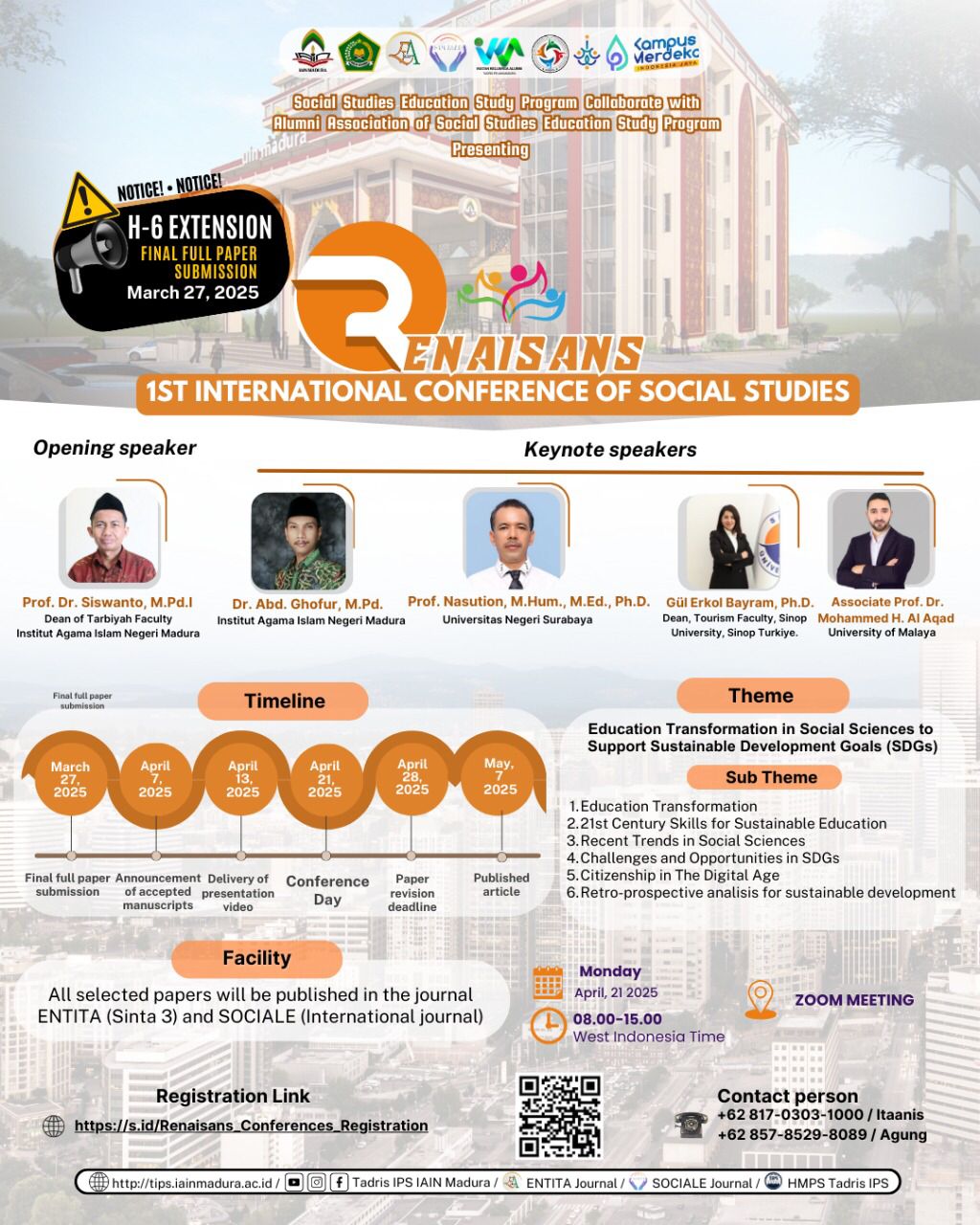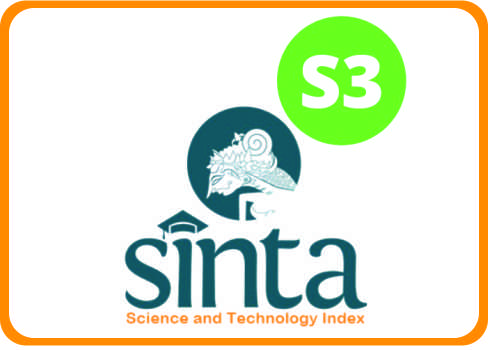Strategic Assessment of the Pentahelix Model in Addressing Prostitution Issues for Sustainable Social Development
 Abstract views: 5
,
Abstract views: 5
,
 PDF downloads: 9
PDF downloads: 9
Abstract
Prostitution, the exchange of sexual services for payment, is widely regarded as a significant social issue across many countries, with no clear consensus on the best approach to solve it. However, there is a lack of research on how to solve prostitution impact in society life. This study aims to analysis the Penta helix model as a strategic approach to tackling prostitution and to identify the key of social institutions that play a significant role in resolving the issue. The research used a quantitative methodology with a percentage technique and involves 60 citizens as the sample localized citizen around former Mbaben or Madusari localization. The instrument in this study is a specially designed closed-ended questionnaire to evaluate sample views toward the Penta helix model in solving prostitution strategy by binary Likert scale. The findings show that the Government Sector received the highest level of agreement, the Business Sector ranked second, the Community Sector followed the third, the Mass Media Sector had the fourth, and the last is the Academia Sector. These results indicate that each sector can contribute effectively to a multi-sectoral approach in addressing prostitution, ensuring a more comprehensive and sustainable solution to this complex social issue.
Downloads
References
Bhat, Rashid Manzoor. 2022. “A Historical Study of Prostitution.” Journal of Media, Culture and Communication (JMCC) ISSN: 1245–2799.
Blum, Douglas W. 2006. “Russian Youth Policy: Shaping the Nation-State’s Future.” SAIS Review of International Affairs 26(2): 95–108.
Cabezas, Amalia Lucia. 2018. “Discourses of Prostitution: The Case of Cuba.” In Global Sex Workers, Routledge, 79–86.
Connelly, Mark Thomas. 2018. The Response to Prostitution in the Progressive Era. UNC Press Books.
Constantin, Elena Claudia. 2012. “Gaining the Young Generation’s Attention.” Procedia - Social and Behavioral Sciences 46: 4130–35. http://www.sciencedirect.com/science/article/pii/S1877042812019489.
Dyllick, Thomas. 2015. “Responsible Management Education for a Sustainable World.” Journal of Management Development.
Gao, Huasheng, and Vanya Petrova. 2022. “Do Prostitution Laws Affect Rape Rates? Evidence from Europe.” The Journal of Law and Economics 65(4): 753–89.
Giobbe, Evelina. 2018. “Confronting the Liberal Lies about Prostitution.” In Living with Contradictions, Routledge, 120–26.
Gonzalez-Arribas, Olga, Sonia Panadero, Irantzu Recalde-Esnoz, and Jose Juan Vazquez. 2024. “Stressful Life Events Among Women Suffering Homelessness and Prostitution in Spain.” Archives of Sexual Behavior 53(9): 3311–17.
Hansen, Michael A, and Isabelle Johansson. 2023. “Asking about ‘Prostitution’,‘Sex Work’ and ‘Transactional Sex’: Question Wording and Attitudes toward Trading Sexual Services.” The Journal of Sex Research 60(1): 153–64.
Harsin, Jill. 2019. Policing Prostitution in Nineteenth-Century Paris. Princeton University Press.
Henriksen, Theresa Dyrvig. 2021. “Do Prostitution and Social Vulnerability Go Hand in Hand? Examining the Association between Social Background and Prostitution Using Register Data.” Sociological Research Online 26(3): 525–43.
Jahnsen, Synnøve Økland, and Hendrik Wagenaar. 2018. Assessing Prostitution Policies in Europe. Routledge Abingdon, UK.
Junaidah, Junaidah, Syarifudin Basyar, Agus Pahrudin, and Ahmad Fauzan. 2020. “Strategic Management Roadmap: Formulation, Implementation, and Evaluation to Develop Islamic Higher Education Institution.” Tadris: Jurnal Keguruan dan Ilmu Tarbiyah 5(2): 335–47.
Lanau, Alba, and Andrea Matolcsi. 2024. “Prostitution and Sex Work, Who Counts? Mapping Local Data to Inform Policy and Service Provision.” Social Policy and Society 23(1): 71–85.
Langford, Malcolm, and May-Len Skilbrei. 2021. “Branding the Nordic Model of Prostitution Policy.” In The Making and Circulation of Nordic Models, Ideas and Images, Routledge, 165–91.
McLeod, Eileen. 2022. Women Working: Prostitution Now. Routledge.
Nakaya, Ayami. 2018. “Overcoming Ethnic Conflict through Multicultural Education: The Case of West Kalimantan, Indonesia.” International Journal of Multicultural Education 20(1): 118–37.
Noetzel, Selina et al. 2023. “Social Campaigns to Social Change? Sexual Violence Framing in U.S. News before and after #metoo.” Journalism 24(6): 1232–62. https://journals.sagepub.com/doi/10.1177/14648849211056386 (March 13, 2024).
Oliveira, Alexandra, Ana Lemos, Mafalda Mota, and Rita Pinto. 2023. “Understanding the Impact of EU Prostitution Policies on Sex Workers: A Mixed Study Systematic Review.” Sexuality Research and Social Policy 20(4): 1448–68.
Platt, Lucy et al. 2020. “Sex Workers Must Not Be Forgotten in the COVID-19 Response.” The Lancet 396(10243): 9–11.
Prajanti, Sucihatiningsih Dian Wisika, Dalila Daud, Syaiful Amin, and Fauzul Adzim. 2023. “A Sustainable Creative Economy Development Model Using a Penta-Helix Approach Based on Local Wisdom in Magelang City, Indonesia.”
Di Ronco, Anna. 2022. “Law in Action: Local-Level Prostitution Policies and Practices and Their Effects on Sex Workers.” European Journal of Criminology 19(5): 1078–96.
Sa’ad Abdullahi, Bashir, and Habeeb Idris Pindiga. 2023. “Tracking the Diffusion of Disinformation on the SDGs Across Social Media Platforms.” In SDG18 Communication for All, Volume 2: Regional Perspectives and Special Cases, Springer, 145–74.
Salvioni, Daniela M., Simona Franzoni, and Raffaella Cassano. 2017. “Sustainability in the Higher Education System: An Opportunity to Improve Quality and Image.” Sustainability 2017, Vol. 9, Page 914 9(6): 914. https://www.mdpi.com/2071-1050/9/6/914/htm (October 4, 2021).
Sanger, William W. 2022. The History of Prostitution: Its Extent, Causes, and Effects throughout the World. DigiCat.
Sarmini, Ms, and Agung Dwi Bahtiar El Rizaq. 2019. “Between Curiosity and Love: The Meaning of Premarital Sexual Behavior for Students in Malang City.” In Proceedings of the 1st International Conference on Social Sciences (ICSS 2018), Atlantis Press, 1592–96. https://doi.org/10.2991/icss-18.2018.331.
Sawyer, Steven, Michael E Metz, Jeffrey D Hinds, and Robert A Brucker. 2018. “Attitudes towards Prostitution among Males: A “Consumers’ Report”.” In Love, Romance, Sexual Interaction, Routledge, 263–79.
Stanitsas, Marios, Konstantinos Kirytopoulos, and Vrassidas Leopoulos. 2021. “Integrating Sustainability Indicators into Project Management: The Case of Construction Industry.” Journal of Cleaner Production 279: 123774.
Wagenaar, Hendrik. 2019. “Introduction: Prostitution Policy in Europe–an Overview.” Assessing prostitution policies in Europe: 1–28.
Wilson, Geoff A. 2012. “Community Resilience, Globalization, and Transitional Pathways of Decision-Making.” Geoforum 43(6): 1218–31. http://dx.doi.org/10.1016/j.geoforum.2012.03.008.
Wu, Huiping, and Shing On Leung. 2017. “Can Likert Scales Be Treated as Interval Scales?—A Simulation Study.” http://dx.doi.org/10.1080/01488376.2017.1329775 43(4): 527–32. https://www.tandfonline.com/doi/abs/10.1080/01488376.2017.1329775 (July 29, 2022).
Yasin, Raheel, and Sarah I Obsequio Namoco. 2021. “Prostitution: A New Dynamic of Discrimination.” Gender in Management: An International Journal 36(4): 553–67.
Copyright (c) 2025 Entita: Jurnal Pendidikan Ilmu Pengetahuan Sosial dan Ilmu-Ilmu Sosial

This work is licensed under a Creative Commons Attribution-NonCommercial 4.0 International License.
ENTITA: Jurnal Pendidikan Ilmu Pengetahuan Sosial dan Ilmu-Ilmu Sosial operates an Open Access policy under a Creative Commons Non-Commercial 4.0 International license. Authors who publish with this journal agree to the following terms:
- The copyright of the received article once accepted for publication shall be assigned to the journal as the publisher with licensed under a

- Journal is able to enter into separate, additional contractual arrangements for the non-exclusive distribution of the journal's published version of the work (e.g., post it to an institutional repository or publish it in a book), with an acknowledgement of its initial publication in this journal.
- Journal is permitted and encouraged to post their work online (e.g., in institutional repositories or on their website) prior to and during the submission process, as it can lead to productive exchanges, as well as earlier and greater citation of published work (see The Effect of Open Access).
- Here is Copyright Transfer Form that author can download and send to OJS during submission.

















